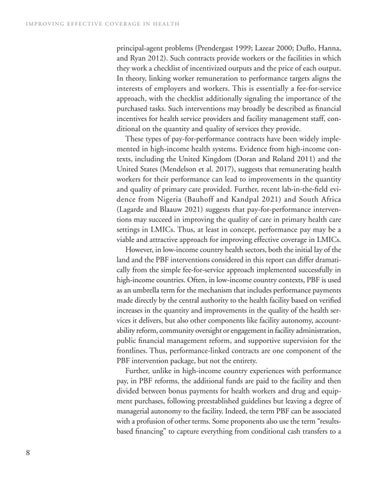IMPROVING EFFECTIVE COVERAGE IN HEALTH
principal-agent problems (Prendergast 1999; Lazear 2000; Duflo, Hanna, and Ryan 2012). Such contracts provide workers or the facilities in which they work a checklist of incentivized outputs and the price of each output. In theory, linking worker remuneration to performance targets aligns the interests of employers and workers. This is essentially a fee-for-service approach, with the checklist additionally signaling the importance of the purchased tasks. Such interventions may broadly be described as financial incentives for health service providers and facility management staff, conditional on the quantity and quality of services they provide. These types of pay-for-performance contracts have been widely implemented in high-income health systems. Evidence from high-income contexts, including the United Kingdom (Doran and Roland 2011) and the United States (Mendelson et al. 2017), suggests that remunerating health workers for their performance can lead to improvements in the quantity and quality of primary care provided. Further, recent lab-in-the-field evidence from Nigeria (Bauhoff and Kandpal 2021) and South Africa (Lagarde and Blaauw 2021) suggests that pay-for-performance interventions may succeed in improving the quality of care in primary health care settings in LMICs. Thus, at least in concept, performance pay may be a viable and attractive approach for improving effective coverage in LMICs. However, in low-income country health sectors, both the initial lay of the land and the PBF interventions considered in this report can differ dramatically from the simple fee-for-service approach implemented successfully in high-income countries. Often, in low-income country contexts, PBF is used as an umbrella term for the mechanism that includes performance payments made directly by the central authority to the health facility based on verified increases in the quantity and improvements in the quality of the health services it delivers, but also other components like facility autonomy, accountability reform, community oversight or engagement in facility administration, public financial management reform, and supportive supervision for the frontlines. Thus, performance-linked contracts are one component of the PBF intervention package, but not the entirety. Further, unlike in high-income country experiences with performance pay, in PBF reforms, the additional funds are paid to the facility and then divided between bonus payments for health workers and drug and equipment purchases, following preestablished guidelines but leaving a degree of managerial autonomy to the facility. Indeed, the term PBF can be associated with a profusion of other terms. Some proponents also use the term “resultsbased financing” to capture everything from conditional cash transfers to a 8

